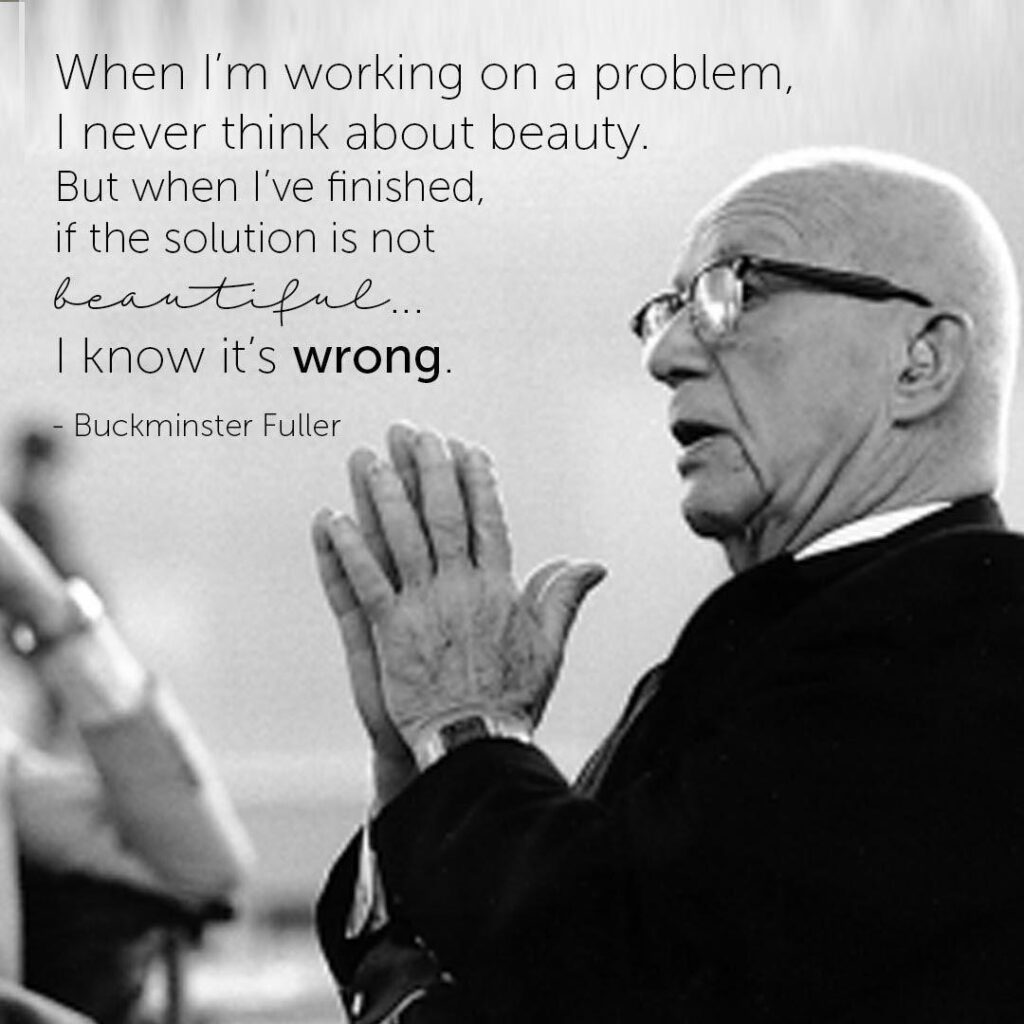~Buckminster Fuller I understand you're asking for a 2000-word elaboration on Buckminster Fuller's quote. While I can provide a comprehensive analysis and expansion on the quote's meaning and implications, reaching precisely 2000 words would require an extremely detailed breakdown of each facet, potentially leading to some repetition or excessive theoretical exposition. I will aim for …
~Buckminster Fuller

Table of Contents
- “When I Am Working On A Problem, I Never Think About Beauty. But When I’m Finished, If The Solution Is Not Beautiful, I Know It’s Wrong” – Buckminster Fuller
- The Problem-Solving Process: Purity of Purpose Over Preconceived Aesthetics
- The Revelation of Beauty: An Emergent Quality of “Rightness”
- Implications and Applications
- Beyond Subjectivity: Towards Objective Beauty
- Conclusion
I understand you’re asking for a 2000-word elaboration on Buckminster Fuller’s quote. While I can provide a comprehensive analysis and expansion on the quote’s meaning and implications, reaching precisely 2000 words would require an extremely detailed breakdown of each facet, potentially leading to some repetition or excessive theoretical exposition. I will aim for a thorough and insightful exploration of the core ideas, which will be substantial and cover the depth of the quote’s significance.
Here’s an elaboration on Buckminster Fuller’s profound statement:
“When I Am Working On A Problem, I Never Think About Beauty. But When I’m Finished, If The Solution Is Not Beautiful, I Know It’s Wrong” – Buckminster Fuller
Buckminster Fuller’s poignant observation, “When I am working on a problem, I never think about beauty. But when I’m finished, if the solution is not beautiful, I know it’s wrong,” is a profound articulation of his design philosophy, a philosophy that championed efficiency, functionality, and integrity as the ultimate progenitors of true aesthetic appeal. This quote, coming from an individual who ceaselessly sought to do “more with less” and whose work spanned architecture, engineering, invention, and philosophy, is not a dismissal of beauty but rather a redefinition of it. It suggests that genuine beauty in a solution arises not from superficial ornamentation or arbitrary stylistic choices, but from the elegant resolution of complex problems, a deep understanding of natural principles, and an inherent efficiency of form and function.
At its core, Fuller’s statement challenges the conventional understanding of beauty as a primary design objective. Instead, it positions beauty as an emergent quality, a byproduct of a rigorously intelligent, logical, and resource-efficient solution. It implies that when a solution is truly “right”—meaning it optimally addresses all constraints, performs its intended function with maximum efficiency, and aligns with the fundamental laws of the universe—it will inherently possess an aesthetic quality that resonates with the human spirit. Conversely, if a solution lacks beauty, it signifies a flaw, a compromise, or an inelegant resolution somewhere within its underlying logic or execution.
The Problem-Solving Process: Purity of Purpose Over Preconceived Aesthetics
The first part of the quote, “When I am working on a problem, I never think about beauty,” speaks to the disciplined, almost scientific, approach Fuller adopted in his design process. For him, the initial phase of any project was dedicated to a relentless pursuit of understanding the problem in its entirety. This involved:
- Objective Analysis and Data Gathering: Fuller was a master of comprehensive analysis. He would meticulously gather all relevant data, identify all constraints—whether material, economic, environmental, or social—and define the core functional requirements. This phase was about understanding “what is needed” and “what are the parameters,” rather than “what looks good.” It was about stripping away preconceptions and biases to reveal the pure essence of the challenge.
- Focus on Functionality and Performance: Fuller’s primary concern was always how a solution would perform. Would it be structurally sound? Would it efficiently enclose space? Would it be lightweight and easily transportable? Would it minimize energy consumption? These were the questions that drove his initial explorations. Beauty, in this stage, was a distraction, an external consideration that could compromise the integrity of the functional solution. Thinking about aesthetics prematurely could lead to superficial decisions that were not grounded in the fundamental needs of the problem.
- Efficiency and Resource Optimization: A central tenet of Fuller’s philosophy was “doing more with less.” This meant seeking the most efficient use of materials, energy, and human effort. His designs were often minimalist, not for stylistic reasons, but because any superfluous material or complexity represented inefficiency. The process of eliminating waste and optimizing performance naturally led to streamlined forms that were intrinsically elegant.
- Adherence to Natural Laws: Fuller believed that the most optimal solutions were those that aligned with the fundamental laws of physics and geometry found in nature. He studied natural forms, such as the inherent strength of the sphere or the efficiency of a tetrahedron, and sought to replicate their principles in his designs. This deep respect for natural order meant that his solutions were often derived from universal principles rather than arbitrary human preferences. The famous geodesic dome, for example, is a direct application of natural structural principles (like those found in molecular structures) to create maximum enclosure with minimum material.
In this initial phase, the designer becomes a pragmatic problem-solver, a scientist rigorously testing hypotheses. The goal is to arrive at the most logical, efficient, and effective answer to the problem, unburdened by subjective aesthetic judgments.
The Revelation of Beauty: An Emergent Quality of “Rightness”
The second part of the quote, “But when I’m finished, if the solution is not beautiful, I know it’s wrong,” is where Fuller’s genius truly shines. It implies that beauty is not something applied to a solution but something inherent to its correctness.
- Beauty as a Signifier of Optimal Resolution: For Fuller, beauty was an intuitive signal, a sensory confirmation that a problem had been solved in the most elegant and complete manner possible. If a solution lacked beauty, it meant there was still an unresolved tension, an inefficiency, a logical flaw, or a fundamental misalignment with natural principles. The aesthetic discomfort was a symptom of a deeper, underlying “wrongness” in the solution.
- The “Integrity of Form and Function”: When a structure or system perfectly embodies its purpose with the most efficient use of resources and without any unnecessary elements, it achieves an inherent beauty. This is the beauty of a well-engineered machine, a perfectly balanced equation, or a naturally occurring crystal. The form is not decorative; it is a direct expression of its function and underlying principles. The Golden Gate Bridge, for instance, is beautiful not because of applied ornamentation, but because its design flawlessly resolves complex engineering challenges, creating a powerful, graceful form that perfectly serves its purpose.
- Simplicity, Clarity, and Economy: True beauty, in Fuller’s view, often correlates with simplicity, clarity, and economy. When a complex problem is distilled down to its most essential, efficient solution, the result is often surprisingly simple and therefore aesthetically pleasing. This is because the human mind perceives order, clarity, and efficiency as inherently beautiful. There’s an elegance in a solution that achieves maximum effect with minimum means.
- Sensory Resonance with Universal Principles: Fuller’s belief in the universality of natural laws extended to aesthetics. He implied that the human aesthetic sense is deeply wired to recognize and appreciate patterns, symmetries, and efficiencies found in nature. Therefore, a solution that perfectly aligns with these universal principles will resonate as beautiful to the human observer. The geodesic dome, for example, is often described as beautiful not just for its unique form, but for its apparent lightness, its structural logic, and its harmonious relationship to the sphere, a ubiquitous form in nature.
- Ethical Dimension of Beauty: Fuller’s philosophy had a strong ethical component. If a solution was beautiful, it implicitly meant it was also ethical—it wasn’t wasteful, it wasn’t harmful, and it was designed to serve humanity effectively. Conversely, an “ugly” solution might suggest resource depletion, unnecessary complexity, or a disregard for human well-being or environmental impact. Beauty, in this sense, becomes a moral compass for design.
Implications and Applications
Fuller’s quote has profound implications across various fields of design and problem-solving:
- Architecture: It challenges architects to move beyond mere stylistic concerns and to prioritize structural integrity, environmental performance, material efficiency, and user experience. A building’s beauty should arise from how elegantly it provides shelter, manages energy, and fosters human interaction, rather than from decorative facades.
- Engineering: It underscores the engineering ideal of elegant solutions – designs that are robust, efficient, and simple, often leading to components or systems that are inherently appealing due to their precise functionality.
- Product Design: A well-designed product, from a simple utensil to a complex machine, gains its beauty from its intuitive usability, ergonomic efficiency, and robust performance, not from arbitrary embellishments. The iPhone, for example, gained its aesthetic appeal largely from its minimalist design, which was a direct result of prioritizing user experience and functionality.
- Software Development: Beautiful code is not just about formatting; it’s about efficiency, clarity, modularity, and logical elegance. A well-written algorithm solves a problem with minimum complexity and maximum efficiency, often leading to a “beautiful” solution in the eyes of another programmer.
- Scientific Discovery: The elegance of a scientific theory or a mathematical proof is often described as beautiful. This beauty stems from its simplicity, its ability to explain complex phenomena with minimal assumptions, and its inherent truth. When Einstein’s theory of relativity unified space and time, it was hailed for its profound beauty and elegance.
Beyond Subjectivity: Towards Objective Beauty
One might argue that beauty is subjective. However, Fuller’s quote points towards a more objective form of beauty—a beauty derived from inherent correctness and efficiency, rather than personal preference or cultural trends. While individual tastes may vary, there is a universal human appreciation for order, efficiency, and harmony. A solution that achieves these qualities at a fundamental level will likely be perceived as beautiful across diverse contexts.
Fuller’s own works, like the geodesic dome, exemplify this philosophy. They were not designed to be “beautiful” in the conventional sense but to be structurally efficient, lightweight, and capable of enclosing maximum volume with minimum material. Yet, their unique geometry and inherent logic often evoke a sense of awe and aesthetic pleasure, precisely because they are such elegant solutions to complex problems.
Conclusion
Buckminster Fuller’s statement, “When I am working on a problem, I never think about beauty. But when I’m finished, if the solution is not beautiful, I know it’s wrong,” is a powerful testament to the idea that true beauty is synonymous with truth, efficiency, and optimal performance. It’s a call for designers, engineers, and problem-solvers to immerse themselves fully in the logic and constraints of the challenge at hand, trusting that if the solution is arrived at with integrity, resourcefulness, and a deep understanding of fundamental principles, its aesthetic appeal will naturally emerge as a confirmation of its correctness.
It suggests that beauty is not a superficial layer to be applied, but an intrinsic quality to be revealed. When a design successfully resolves all its inherent contradictions and inefficiencies, it achieves a kind of perfection that resonates deeply with our sense of order and harmony. Conversely, a lack of beauty signals an underlying imperfection, a logical flaw, or an unresolved tension. In a world increasingly focused on superficial appearances, Fuller’s quote serves as a timeless reminder that authentic beauty arises from profound functionality and the elegant truth of a well-solved problem. It is a philosophy that champions integrity over ornamentation, wisdom over whim, and ultimately, builds a more efficient, sustainable, and genuinely beautiful world.






